FOF Best of 2022
Updated: Jan 20
THE YEAR OF THE FOUR-ISH STAR FILM
It's a frequent debate that my best film buds and I engage in all too regularly these days. It always begins the same way. One of us trots out the central question - Was it a good movie year? Someone else responds, and soon we’re all marshaling evidence for our conclusions, as we draw imaginary battle lines in the nonexistent sand. Now, it would seem that the inquiry has always been relevant to a degree. After all, one could argue that 2010 was a better film year than 2012 or any other such comparison. But for some reason the query has felt more dire in these days.
We could, of course, traipse out legions of reasons why this is the case - the death of the box office middle, the meteoric rise of inflated budgets (and consequent star talent behind and in front of the camera) in prestige TV, the explosion of high grade tech for mid-level prices in home television and stereo equipment, and the, uh, call it social reticence to be “out in public” since the pandemic swept across the planet - to name a few. Irregardless of the exact cause, there is an underlying suspicion that perhaps “movies are in trouble.” The thousands of theaters that were shuttered in the last 18 months could be one data point in such a claim.
And yet, the more widespread proliferation of both independent and major studio (shrinking though they may be) releases in the US and all over the world has never been so encouraging. Ditto the KINDS of stories we are now hearing from the marginalized and from cultures everywhere. Couple this with the ease of availability from innumerable streamers and the near hyper-speed turnaround from box office to VOD, and one could avow the exact OPPOSITE is true! “Movies aren’t in trouble,” he or she would proudly proclaim. “Things have never been better!”
So, where do I stand? Well, perhaps predictably, I’m in the boring middle. You’ll notice I’ve entitled this introduction "the year of the four-ish star film." That is precisely how I feel. I’m so grateful for the variety of stories, the depth of themes, the remarkable auteurs we had churning out productions in 2022. Yet SO FEW reached transcendence for me. Only one film, in fact, ascended 5 Star Mountain. Cinema is changing, of that I am sure. But I don’t think movies are going anywhere. This year left us with a whole lot of really good flicks. I endeavor to speedily highlight 20 of them below. Here’s hoping more great ones are coming in the years ahead.
*Disclaimer: Listen, if you're a real "Furman on Film head" (we really do need a better appellation for our hive), you'll be acutely aware that this list differs from the Best of 2022 video I did with three of my cinephile star besties just a few short weeks ago. Well, the truth is there are at least four pictures here that I hadn't seen then, and a host of others I "revisited" in some shape or form since. These "best of's" are always changing and evolving. They're mere approximations of the bright light cinema shines in the cosmos anyway. In two, four, 10 years I'll surely disagree with half of this. Apologies, dear reader. Consider this the "official" hierarchy. At this moment. For now...
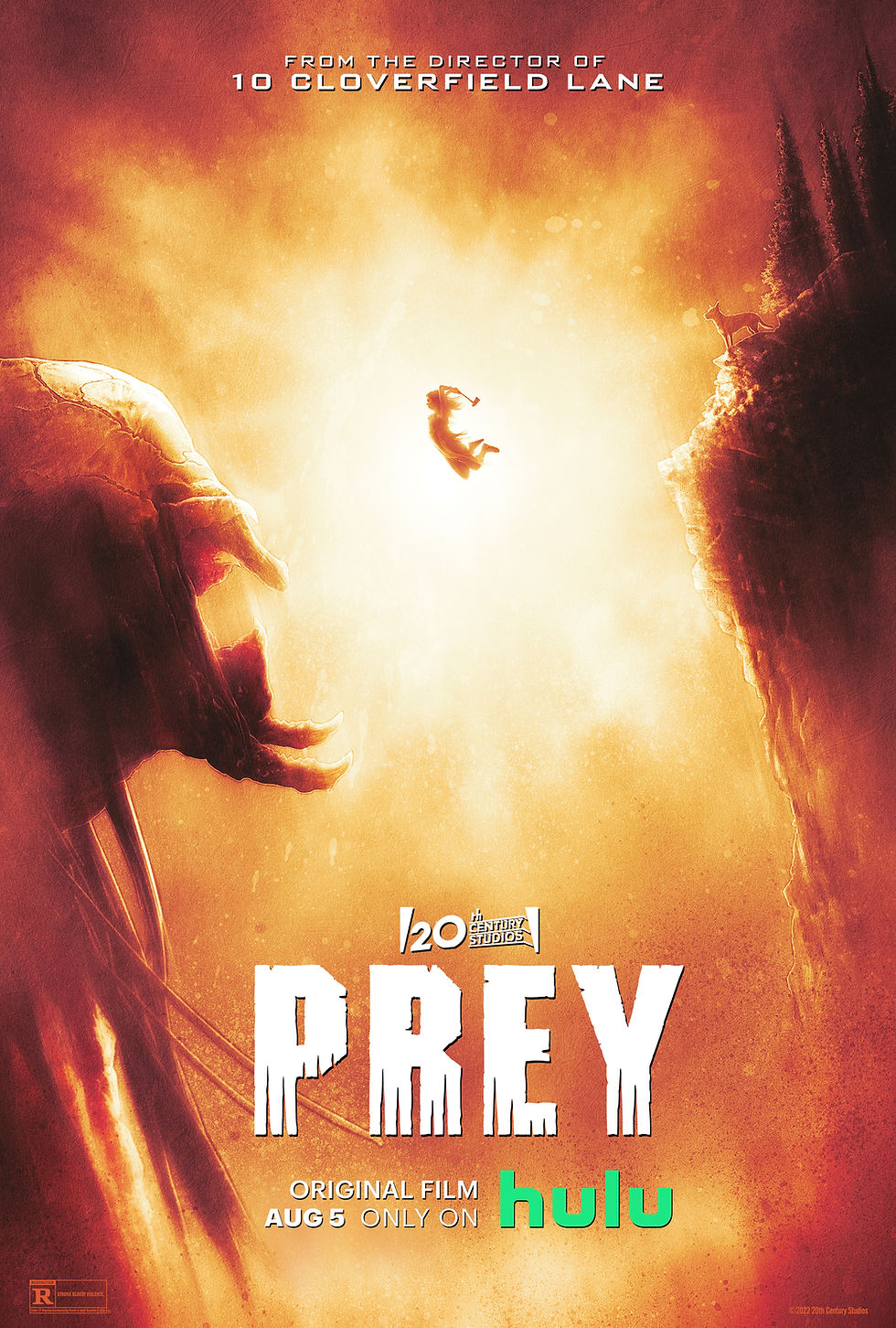
# 20 Prey
In 1987, actioneer John McTiernan dropped the first of his holy triumvirate of action bangers on the world with Predator. The film starred a sick alien, a scorching jungle, and enough body butter on beefy boys for a lifetime. Give me peak Arnold and Carl Weathers clasping arms all day long. The trouble is, well, a franchise was born. And the rest of the Predator flicks are, to put it plainly, quite bad. Sure, I hear some of you grumbling in the back. A few will ride for Adrien Brody’s Predators from about a decade ago (it’s fine). The stranger folks among us will vamp on the myth of Shane Black and ’18 The Predator’s greatness (it’s not). But, by and large, the chasm between the original masterwork and its collection of sequels mirrors the wage gap inequality in South Korea.
Until now! That’s the first thing we’ve got to say about Prey - they actually made a great Predator sequel! Boy, is it ever. In point of fact, as a sleek, well-paced, high tech thriller, one could argue that this even surpasses the hokum of the original. I won’t quite go that far, but when you couple director Dan Trachtenberg’s smarts with the fact that this epic grants us a representational narrative about a Comanche woman warring against gender roles in her tribe and her own fierce spirit, the case grows stronger. Turn your brain off and come for boldness, war paint, and a triumphant heroine combating advanced alien weaponry and ferocious creatures. But stay for the unique saga foregrounding the Comanche Nation. If we MUST have more Predator sequels, heaven help us make them all like this.

#19 Jackass Forever
When the first Jackass film dropped in the world’s lap 21 years ago (after two years of a successful MTV show), I can picture professors in film studies classes everywhere deriding it as pure, debaucherous filth. In fact, I heard director Alex Ross Perry relaying as much on a podcast earlier in ’22. Yet now, decades later, we have Jackass Forever, a work whose shocks and laughs is only superseded by the amount of male genitalia onscreen. Not only has the franchise lived on, this may be the strongest of them all! See, this is how so many cult classics are born to the world. These guys are thought to be drunks, druggies, thrill seekers, and just plain old dummies. No antecedent can be found in the world of art or entertainment, right?
As a matter of fact, I disagree. The Marx Brothers, Charlie Chaplin, and Buster Keaton all touched on a similar nerve. Of course, there was far less of the grotesquery, but they understood the physicality of comedy and the humor of pre-arranged, ridiculous situations. Or how about Harry Houdini, or any of vaudeville? The spectacle IS the human beings themselves, engaged in acts which both thrill and, in many instances, contain notes of real danger. It’s that trepidatious moment before the stunt, or the wild animal enters, or the gag drops that all the viewers are in on but of which the participants have no clue. Just bottle that up as pure adrenaline-charged hilarity for the masses. As these men have grayed and continued to show both their balls (figuratively and literally) and the power of male friendship, they’ve EARNED the respect of the intelligentsia. Or, you know, just turn it on and feel your sides split.
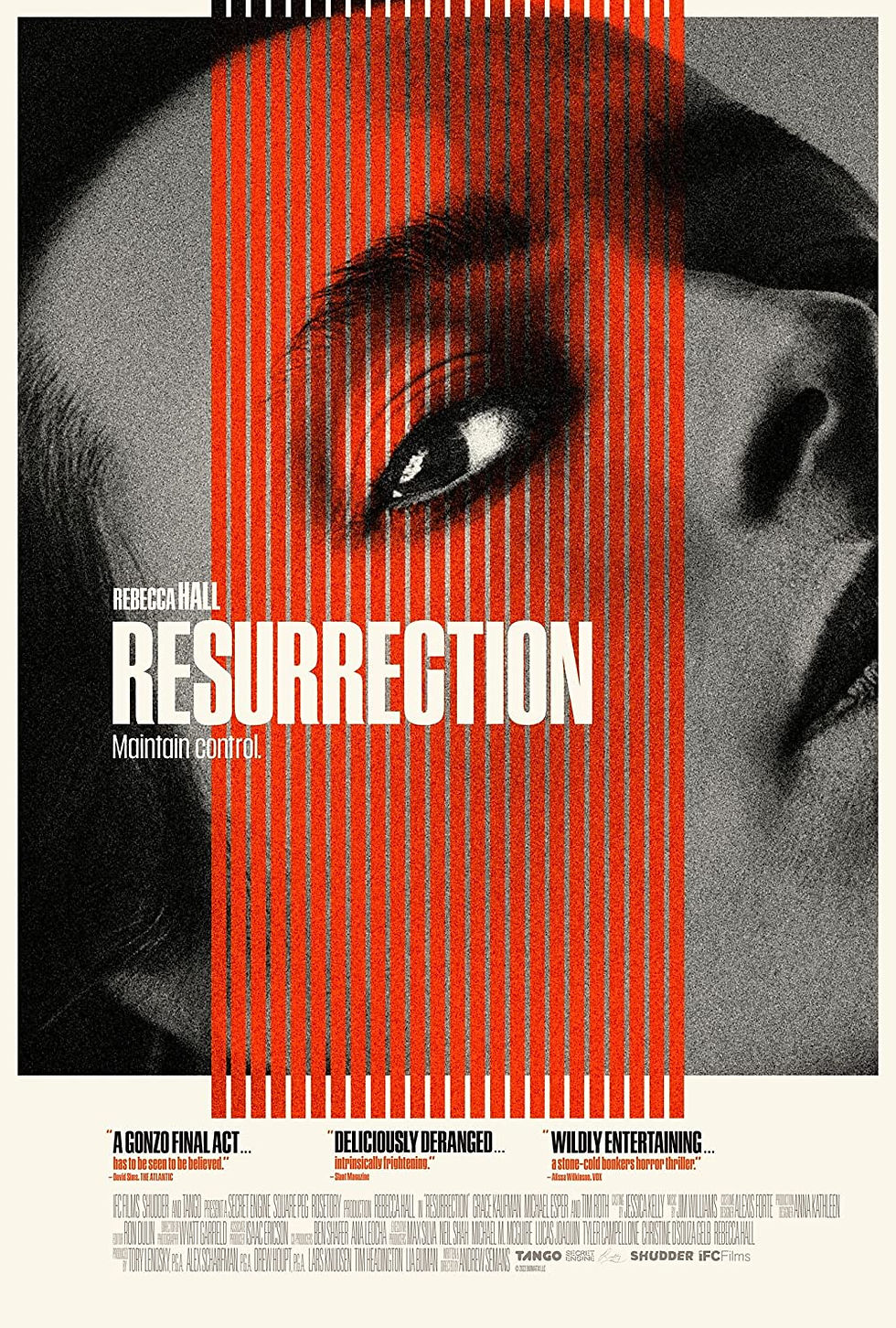
#18 Resurrection
Of all of the angry, bitter Oscar BS takes I possess (they are legion), the lack of awards recognition for Rebecca Hall may just take the cake. I’ve been shouting from the rooftops since The Town that she has the goods and deserves to be at the center of more projects. Last year, I highlighted her work in the brainy horror flick, The Night House. Here I stand again in praise of Resurrection. I’ll say, for starters, that this film is a doozy. As I said in my review at the time, this work “belongs to an ilk of flicks about imperiled women in manipulative relationships where they are groomed for service, yet somehow find their way through the abuse to fight back.”
Only, this time, Resurrection doesn’t proceed like so many of those other made-for-cable Sleeping with the Enemy-style potboilers. Where they go broad, Andrew Semans’ work drills deep, into the subterranean level, where the psyche meets the surreal. Hall is a woman hiding a secret, a past trauma which leaves her grasping for tight control of her world. Soon, we witness this calm and composed leader begin to unravel when the chilling Tim Roth enters the scene. He seems like the kind of man who could groom and torture a woman, eroding her very sense of self, all while flashing the biggest sadistic grin. So, the dance of hunter and prey commences and continues until a shocking denouement brimming with possibilities. With a finale hinting at the nature of PTSD and relational abuse, Semans and co. have crafted an exquisitely well-acted and tightly honed thriller that rises above so much of its fellow genre fare.
-Check out my full review of Resurrection here
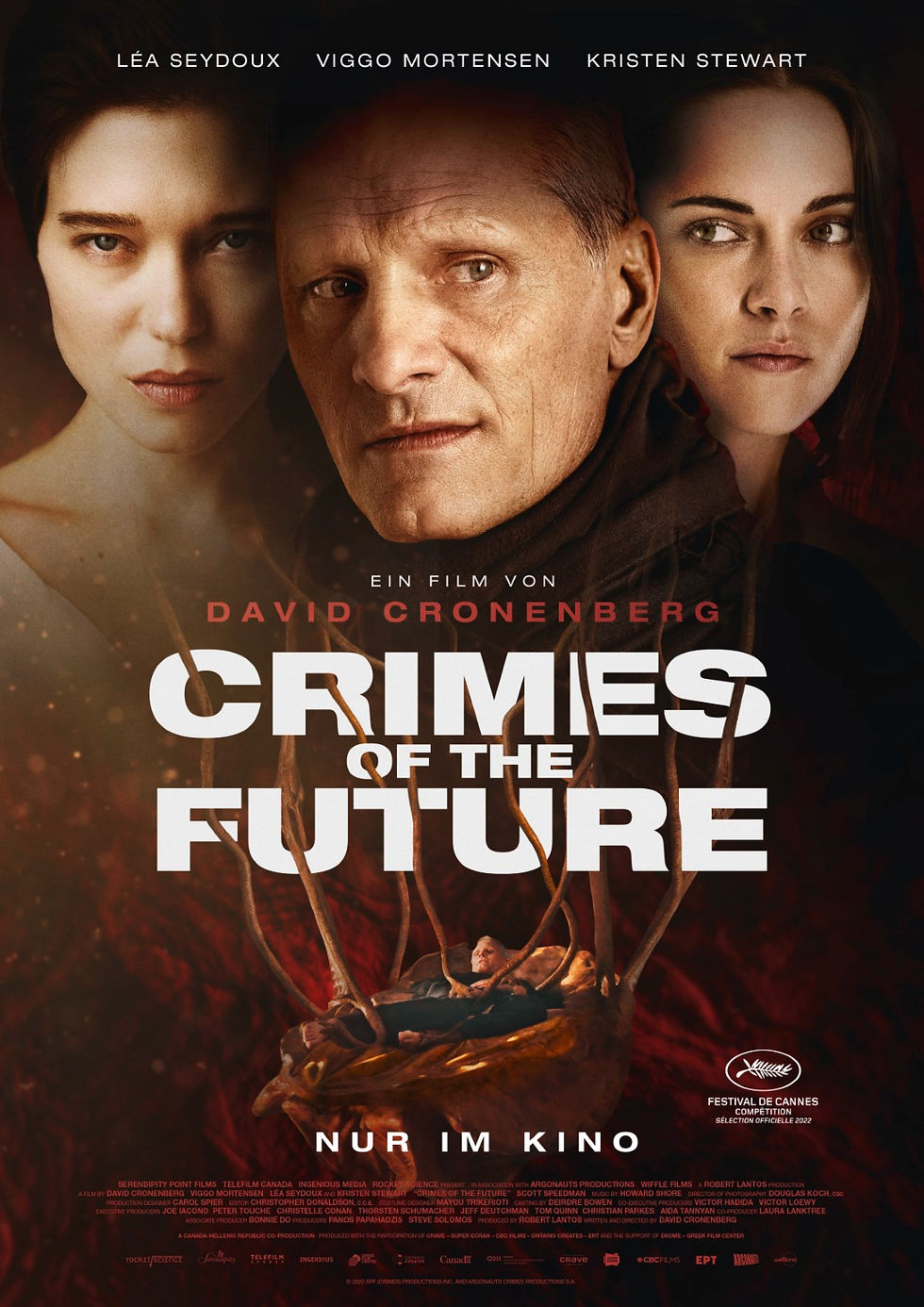
#17 Crimes of the Future
Hi, my name is Nick, and I’ve been a recovering David Cronenberg addict for 18 years. (Editor’s note: FOF is in NO WAY attempting to denigrate the brave folks at AA for their hard work and progress won in the fight for sobriety). But it’s true. As I said in our launch video, the Canadian auteur’s best “stuff” combines deep philosophical themes with grotesque yet sightly body horror. Crimes wants to be that picture desperately. But it’s just a bit too shaggy, too rough around the edges, especially in its third act to reach that transcendent plane. Speaking of Mt. Rushmore DC pics, Crimes recalls his early 80’s satirical masterwork Videodrome in several regards. Though it's highs are nowhere near as high, both wrestle with the nature of technology and the human body, how the former affects and transforms the latter.
But this time around, ole’ Crone appends some brand new commentary on modern art cliques, the performative nature of that arena, and cultures of obsession built around public personas. At the center of the latter is my favorite performance of the picture, a completely unhinged Kristen Stewart, acting as an obsequious government agent spellbound by Viggo’s bodily creations. (As the world grows more synthetic, avant-garde artists like Viggo’s Saul display their bodily metamorphoses in public spectacles).
This is all well and good. But then things, as they often do in a Cronenberg flick, get weird. There are rebel factions in this futuristic sci fi world and a mole in the bureaucratic entity looming just out of frame. Soon everything comes crashing down in a third act that, though imperfect, is nonetheless unforgettable.
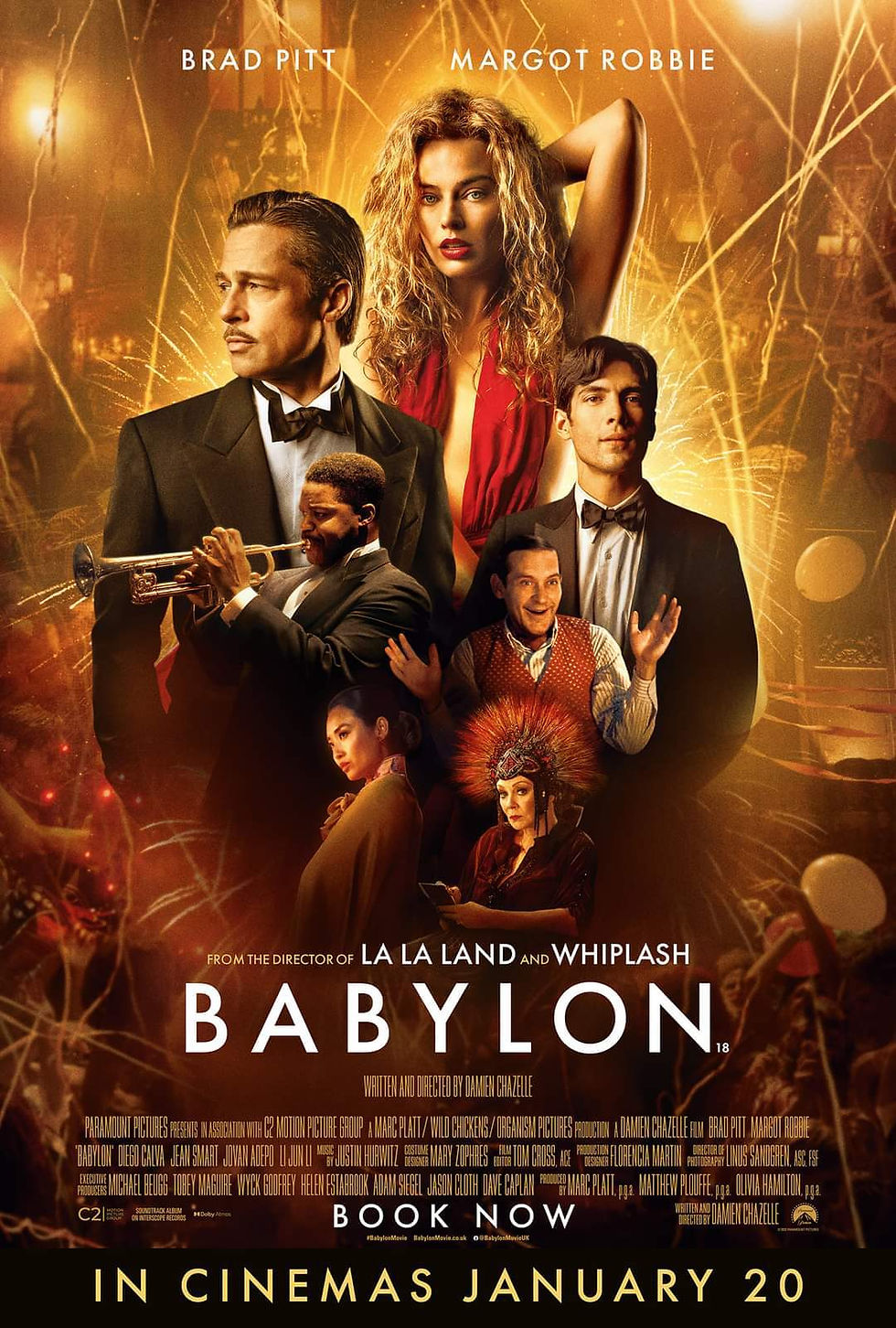
#16 Babylon
Was there a more divisive film in 2022 both critically and, well, commercially than Damien Chazelle’s Babylon? Or perhaps I should say, one prone to evoke both effusive praise and tongue tsk-ing moralizing in equal measure around the proverbial “water cooler.” Babylon is many things. Subtle is not one of them. This unwieldy behemoth, like the elephant which defecates on a poor worker close to the opening frame, is a three plus hour juggernaut. It is overstuffed and off the rails. It not only depicts the white powder onscreen from time to time, it seems to simulate the very experience of partaking in it (so I've heard) in its frenetic pacing, expansive extra-laden sequences, and whirling camera dervishes. This director’s vision and execution boasts guts for days, and it’s a good thing too. After all, what better way to send up an era of hubris than to indulge in some of your own debased excess?
Now I have many critical thoughts about Babylon as well. Despite its epic construction, it lands lower on the list due to a number of factors. Most notably, in the third hour, Chazelle tries to move into a rather wistful meditation on the fleeting nature of fame and the way the Hollywood machine can swallow you up and spit you out. I simply found some of these disparate plot threads to be rather derivative and less engaging than what preceded. BUT…this film which swings so hard for the fences is never less than beautiful. It is often, in fact, mesmeric. The performances are roundly solid. Every SINGLE sequence about the act and art of making movies is jaw-droppingly stunning. An act of pure self-indulgence, though this may seem, Babylon nonetheless showcases punctilious craftsmanship in every "below the line" category. And the way that the theme of transformative "movie magic" being built on a heap of bile, vomit, and excrement lingers with the viewer is about as fitting an homage to old cinema as one could find.
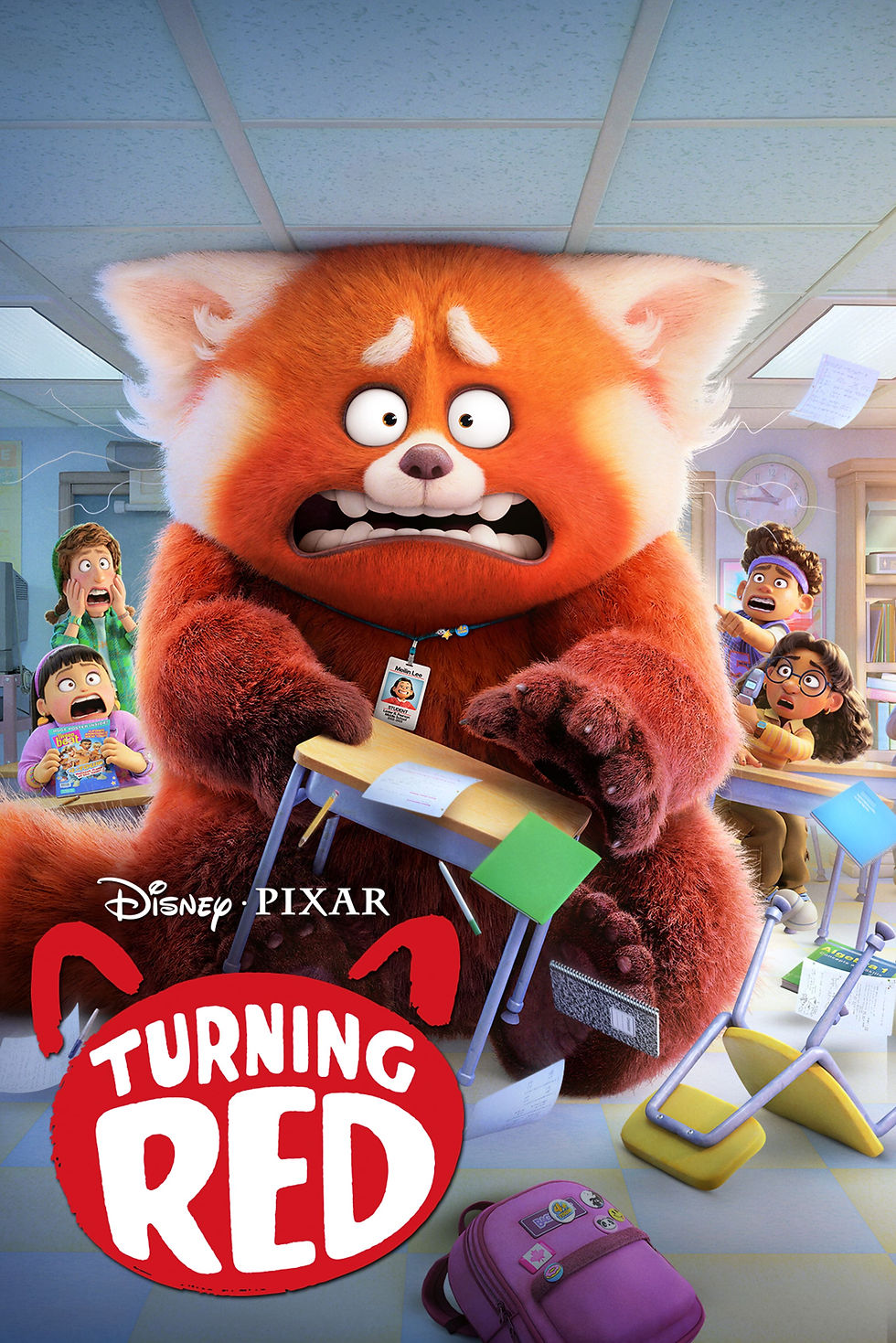
#15 Turning Red
There was much talk during this past year (and rightfully so) of directorial debuts in movies. Many of them came from women. (One which we will see much further down the line in this list, in fact). But for my money, Domee Shi has just about as strong a case as anyone else for the remarkable product that Turning Red is. So, the obvious question becomes - How can you love this, Nick? A film about a pubescent girl who adores boy bands and transforms into a giant red panda whenever life just gets a little too tough. Well, the question is fair, but Shi’s film is simply a special kind of coming-of-age comedy, with strong autobiographical notes of growing up as a Chinese Canadian. Turning Red also boasts some of the most unique Pixar animation I’ve yet seen. The characters are full-fleshed, round, and expressively big-eyed. The director claimed that this was inspired by the world of anime, and so she sought to meld this 2D style, which captures authentic expressions and imperfections so well, with 3D animation.
The result, to my mind, is simply breathtaking. But I love Turning Red for much more than the visuals and cultural representation. This is a great story for teens undergoing the confusion of growing up and the parents holding on for dear life through that transition. For the time when youths wake up and hardly recognize their own bodies or the emotions pulling them in 1000 different directions. One of these movements is surely a turn away from the adults that reared them. Yet, another hangs on to those vestiges of childlike wonder and reverence for the big people in their lives. Turning Red simply deals with these big feelings and a vital transition period in kids’ lives with humor and grace, and a story that stays firmly grounded even as it dips into giant pandas, bamboo forests, and the wonder of magical realism.
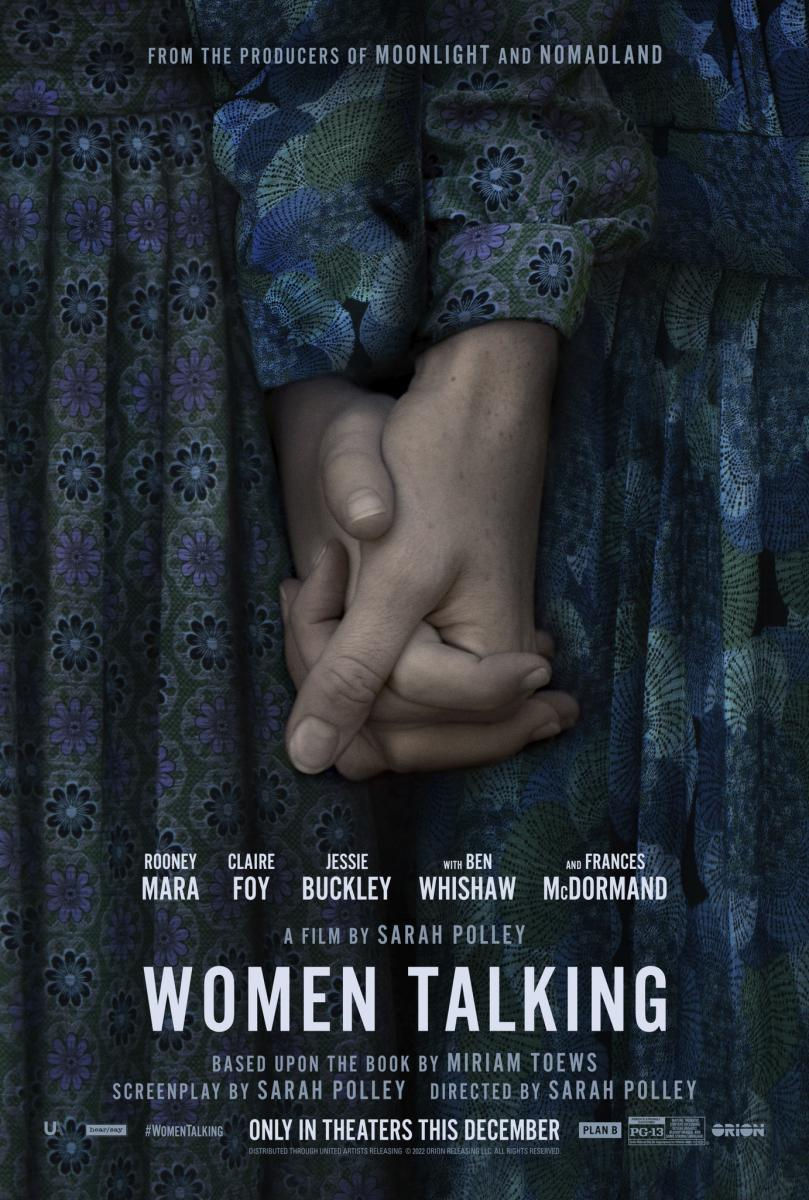
#14 Women Talking
Never before in the history of cinema has a more apropos title been placed on a work of art. For Women Talking is both populated with and ALL about…you guessed it. Sarah Polley places its ultimate purpose right there in the opening credits - “a work of female imagination.” Were I the title card writer (I’m not), I would add the word “sacred” to that description. A work of sacred female imagination. A group of women who, rallying together after sexual abuses at the hands of men in the community continue to rain down upon them unchecked, come together for a vote: “Do nothing. Stay and Fight. Leave.”
After all the women’s selections have been counted, the latter two are dead even. So, a council of prominent members from several families is gathered in a hayloft to decide the entire group’s fate. And for the next 100 minutes, in this small wooded room, with rafters overhead and hay bales all around, this is exactly what they do.
Now, once it sets the table, Women Talking does have some difficult work to do. For in forsaking any outside action or drama, it eschews entertainment for its audience. Again and again, director Sarah Polley opts for simple storytelling, choosing to foreground the straightforward nature of the points being made and the overall message. But see, none of this is really uncomplicated at all. The story is all about wounded people wrestling with how to reconcile brutal truths with their committed faith. As the picture deepens, and these character’s inner hearts and motivations are opened like a flower before us, genuine intrigue and drama DOES arise. But it is never external to the grappling. It is rather, in point of fact, the natural consequence of setting Jessie Buckley, Rooney Mara, Claire Foy, and SO many others loose to express, emote, and steal scenes from their peers one after another in succession. You could ask ten different people who their favorite performer was in Women Talking and get ten unique responses. Yet Polley goes even further, in Ben Whishaw’s character granting us a riveting portrait of the powerful allyship men are capable of in the face of such trauma. It’s all masterfully rendered, a hard hitting film that feels as relevant today as it would have decades, even centuries ago.
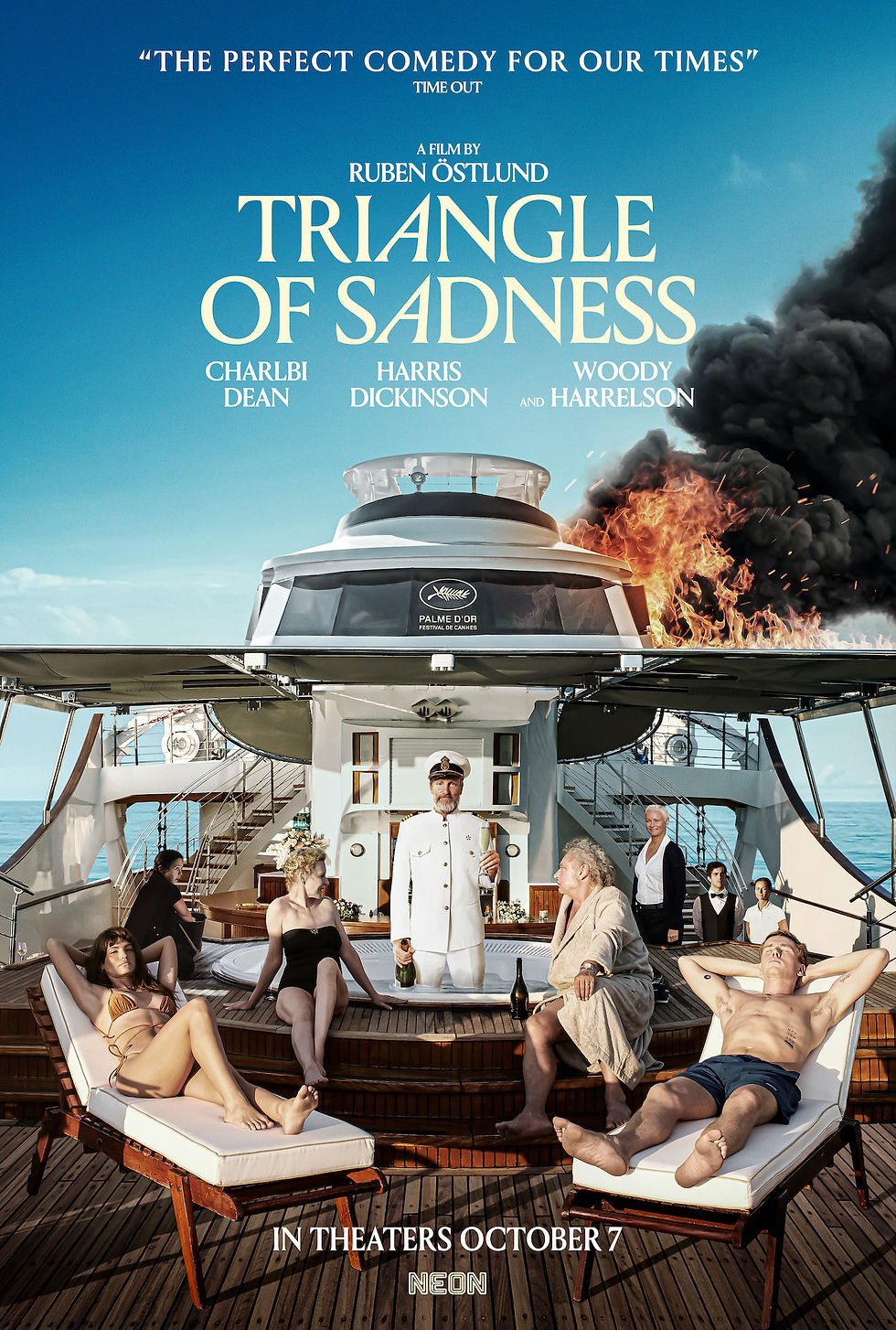
#13 Triangle of Sadness
Triangle of Sadness is the third of Ruben Ostlund’s informal trilogy loosely grouped around a central theme. Put simply, that motif is something like “Rich people suck.” After Force Majeure (which is likely the strongest of the bunch) and the art world takedown The Square, the Swedish director gifts us a new work which is both more broadly comic and less satirically profound than its forerunners. In other words, it’s quite possibly the worst of the bunch overall, but its highs are in the stratosphere. In this one, Ostlund has put his finger on the dynamic interplay of power and wealth. More specifically, the film is an incisive look at the systems which enforce inequality and what might occur if those were upended.
Structurally, the picture is tripartite. The first act essentially centers on one couple, Carl and Yaya. The two are both models and social influencers and are out for dinner together. Soon, we are flies on the wall to small social pleasantries like the man offering to pay for dinner (despite his far poorer financial situation). Then, as Ostlund is often wont, the encounter grows ever more awkward as the two begin to breakdown relational roles and social expectations.
In the second act, that same couple are on a rich cruise together. Much more could be mentioned about this comparatively weak section, but suffice it to say that it features a cadre of solid characters with far too much disposable income finding little ways to piss and moan about their experience onboard (The “triangle of sadness” here is both the way our eyebrows sometimes furrow and a broader descriptor of the unhappiness of the extremely wealthy). At any rate, this ultimately gives way to a masterful third act which turns the tables on all of these power dynamics and punctuates the real value of being “good with your hands” in a world gone cashless. In the end, Triangle features a remarkable star turn by Dolly De Leon and a finale which is satisfyingly shocking even as it offers its own new mystery.
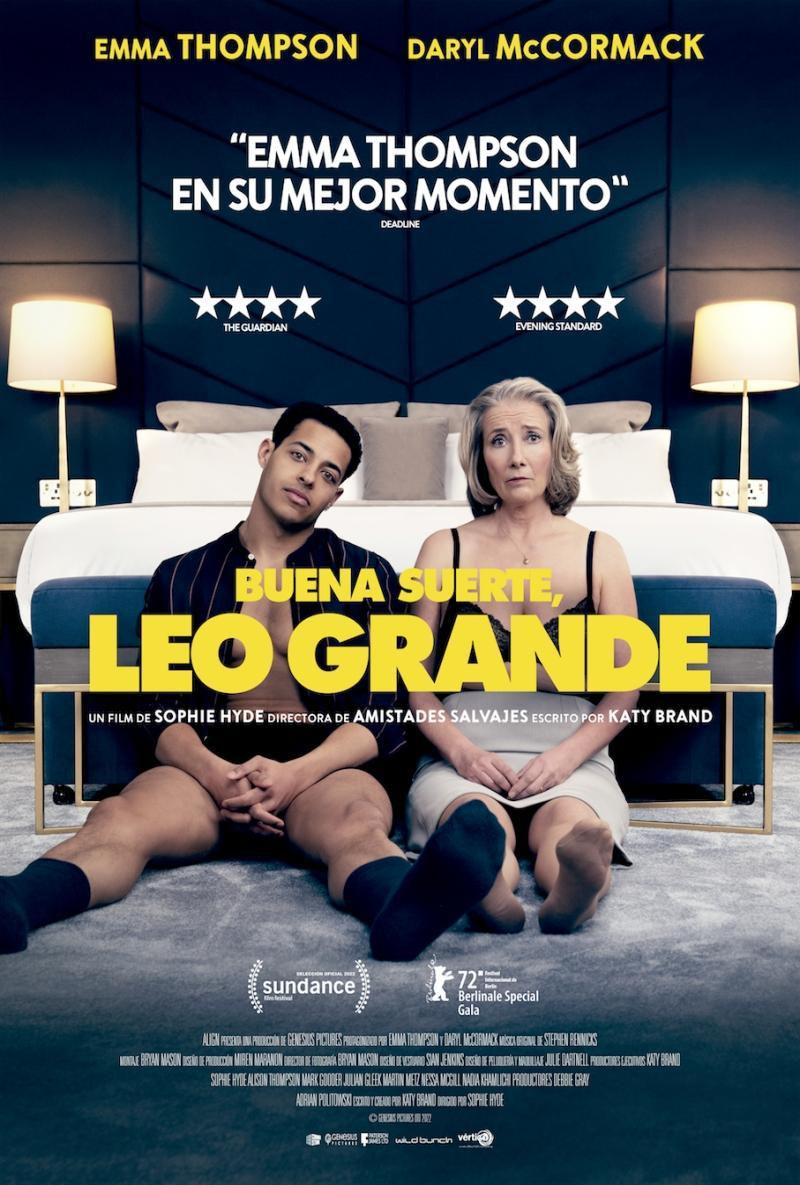
#12 Good Luck to You, Leo Grande
Here lies the most underrated film in the entirety of cinema in 2022 for yours truly! I searched far and wide, from major publications to fledgling sites, sea to shining sea, and nary a one had Good Luck to You, Leo Grande on their year end best of list. Now, in all fairness, I have to say there’s a part of me that gets this. The picture is rough around the edges. It bears the telltale signs of a young director. Most notably, as it rounds the corner into its final act, it stumbles for a stretch before recovering nicely in the finale.
But when it’s good, oh it’s glorious. A brave and authentic two-hander which traffics in wrong footing the audience on taboo subjects and employs the psychology of sex as its vernacular. Could there BE a more readymade film for this guy? (Chandler voice) Listen, sometimes I just like to sit and listen to two incredibly winning and captivating people share a small space and an even more intimate connection. I know what you're thinking. But, Good Luck to You isn’t terrific because of its physicality. No, it’s in the guts where the power lies. This is the most courageous performance I’ve seen from a female lead in many moons, and the very BEST of Emma Thompson’s career. It’s a picture about repression, desire, exploration, and the stultifying roles in which we are sometimes placed. I was rarely less than riveted.
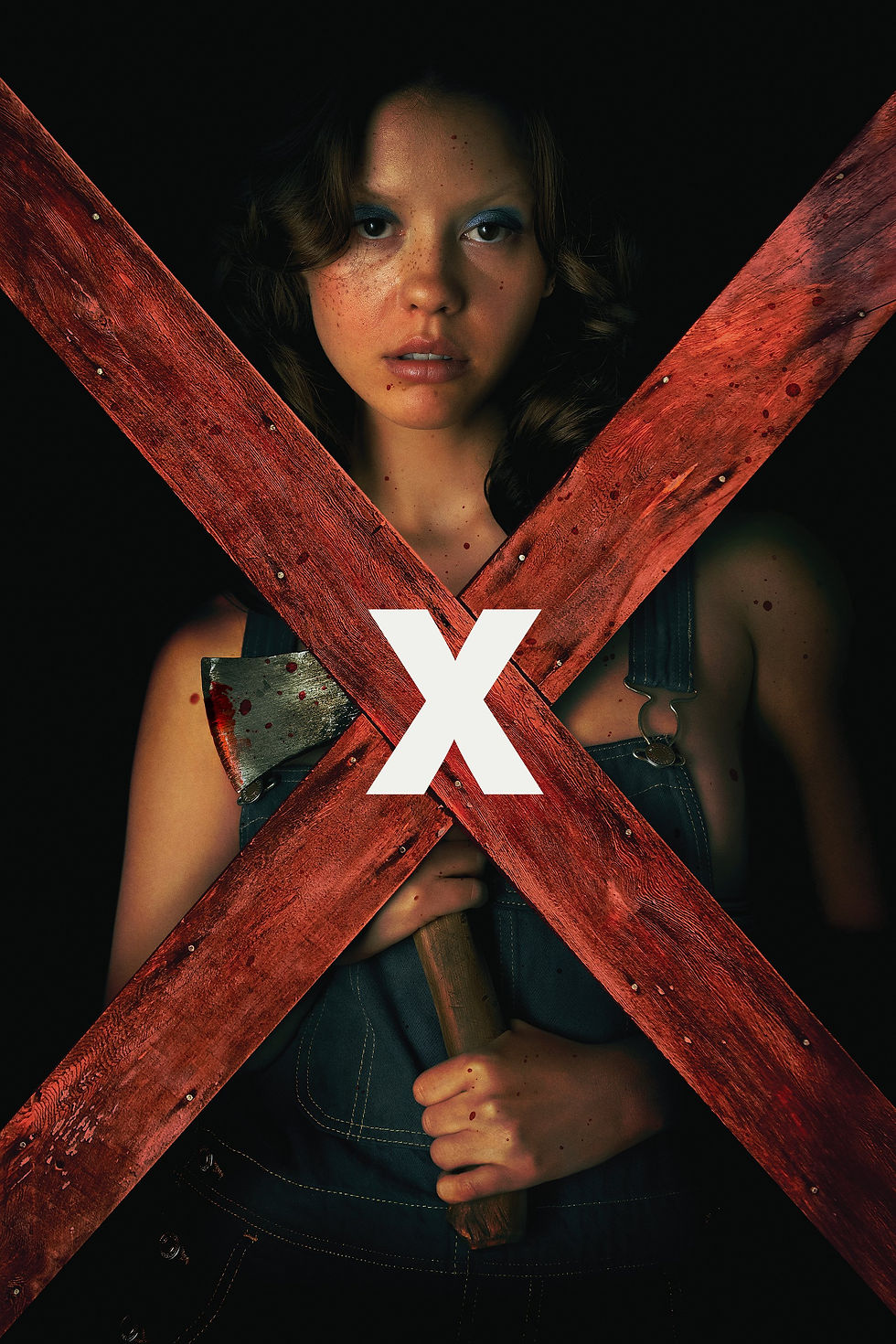
#11 X
Listen, Shocktober is a BIG deal for yours truly. In the course of the past year, I read about and saw so many horror pictures fly in and out of my purview. Different folks riding for horror flicks, horror comedy amalgams, and so much more. I watched everything from Barbarian to Bodies Bodies Bodies, Speak No Evil to Smile and a host of others. As is often the case, many held deep reflections on the nature of the world, and a few were genuinely thrilling. But, try as I might, I just KEPT coming back to Ti West’s X. As I’ve thought deeper, I think the main reason is that this is a slasher flick, but one that is almost entirely sui generis. For starters, its aesthetic is all Texas Chain Saw. Yes, X is a clear throwback to 70’s grindhouse. As such, it feels of a piece with those pictures, yet it has many new tricks up its sleeve.
I could start with the fact that this brings together two of the more salacious genres in existence - slasher horror and amateur porn. But what is more remarkable is how well fleshed out and idiosyncratic these moronic characters really are. For one, the acting of Jenna Ortega and Mia Goth, even Brittany Snow is quite solid. You’re not supposed to care about characters in slashers. You’re CERTAINLY not supposed to care about wannabe porn stars in slashers. Yet we grieve when so many meet their end. Furthermore, there is all kinds of slow burn atmosphere in X as well. There are grindhouse aesthetics, to be sure, but they are adhered to terrific camera blocking and staging, and genuinely artistic edits. Finally, West even hints at bigger thematic exploration here - from perennial fears of aging and the loss of relevance to the fading nature of beauty. The director nudges us toward such inquiry but then is content to turn up the tension and go slashing. This seedy, backwoods porn shooting escapade is simply the best time I had at a horror film all year.

#10 Broker
Here begins a stretch of two films which could broadly be classified as “road movies,” but which offer extremely unique takes on that well-worn formula. Broker, Hirokazu Koreeda’s latest work, finds the Japanese director working with an able and empathetic group of South Korean actors. It chronicles the adoption box phenomenon found in many churches in that nation. Only here, we spend much of our time with two men who commit crimes, swiping babies left at the church’s door, clearing the footage of the drop, and offering them to rich clientele in the black market instead. This affords those willing to pay the opportunity to circumvent the bloated bureaucratic adoption policies of the Korean government. It also leaves these two men with a pretty pay day. Things turn, however, when one mother returns shortly after her fateful decision. She soon decides she will join this ragtag group as they travel to potential buyers around the country.
Now, you’ve probably astutely observed by now that this is not your standard road trip fare. How could a picture about selling babies be funny? Well, that’s the genius of Koreeda, you see. It’s in the way he layers experiences with these characters to give them depth and emotional currency. And some of them are baldly hilarious. As the four travel (they pick up another orphan along the way), they connect with each other, and in the course of this quietly sincere tale, with all of us as well. A staple of this director’s films is exploration of the ways families gel together, of their very nature deep down. Here, however, it is not merely about the power of found family, but also the ways souls long for intimacy in the face of alienation and abandonment.
Now look, the films moves at its own rhythm and pace. I would say that the first hour is greatly diminished by the whopper that is the second. But, Broker simply has two or three of the best scenes I’ve seen all year. One is simply an affirmation offered characters for being born, for existing in this space. Another underscores the difficulty of the human experience, and how love can be shown in the most trying of times. Taken together, it’s a rather eccentric work that melds together road comedy, found family, and even criminal elements (with the two detectives following these folks) into a satisfying emotional journey.

#9 Hit the Road
No film this year blended belly laugh-inducing comedy with wistful drama like Panah Panahi’s Hit the Road. Have you ever been trapped in a car with, say, a four year old whose loud, irreverent brashness is only outpaced by his treacly sweet precociousness? You know, the kind where you kinda just want to deck the kid in the face, if it weren’t for how freaking sweet he was. Well, if you haven’t, you’re about to be. Don’t worry though, you will leave the experience exceedingly transformed. This picture takes us on a road odyssey, with a family of four (father, mother, an adult son, and the aforementioned baby brother) questing for some promise of freedom as they ride on towards the Iran-Turkey border.
There is a couple of things that need to be said in context here. For starters, as my great friend Scott Sipling (self-designated Iranian film guru) always puts it, “NO ONE does landscape cinematography like Iranian filmmakers.” He’s nowhere near wrong, and this one features some of the most breathtaking countryside shots you’ll ever see. Further, if you’ve followed the country’s productions for any period of time, you’d note that their pictures are often thorny and massively complex - A bit like trying to swallow an entire pack of Saltines without a single drop of water in sight (read: difficult to digest).
Here’s the thing - Hit the Road bears NONE of this difficulty. This is a movie brimming with modern cultural references, from a hilarious scene with a biker who idolizes Lance Armstrong, to potty humor, namedrop references to Batman and films like 2001. It’s never dull, and at about 90 minutes, it goes down REAL smoothly. But that is not to say that it isn’t a hefty work. No, Panahi has given himself the difficult task (following in the lineage of his filmmaking father before him) of using one family’s saga to add incisive commentary on society writ large. As the story unfolds, we’re granted some access to just why this family is traveling in the first place and a potential separation that looms. There is always tragedy and hints of deep pools of sadness just below the surface.
Once the film rounds the corner for home, Hit the Road completes its evolution from light-hearted road comedy to heartbreaking calamity. Like his father before him, Panahi finds that special sauce of yarns which are light on their feet but inevitably unfold to surprising depths. Hit the Road is like Little Miss Sunshine if behind every cultural gag there was a family haunted by some crushing sociopolitical demand. It’s that balance - of tragic loss and innocent joy, profound truth and the absurdity of existence - that makes this one an unforgettable experience.
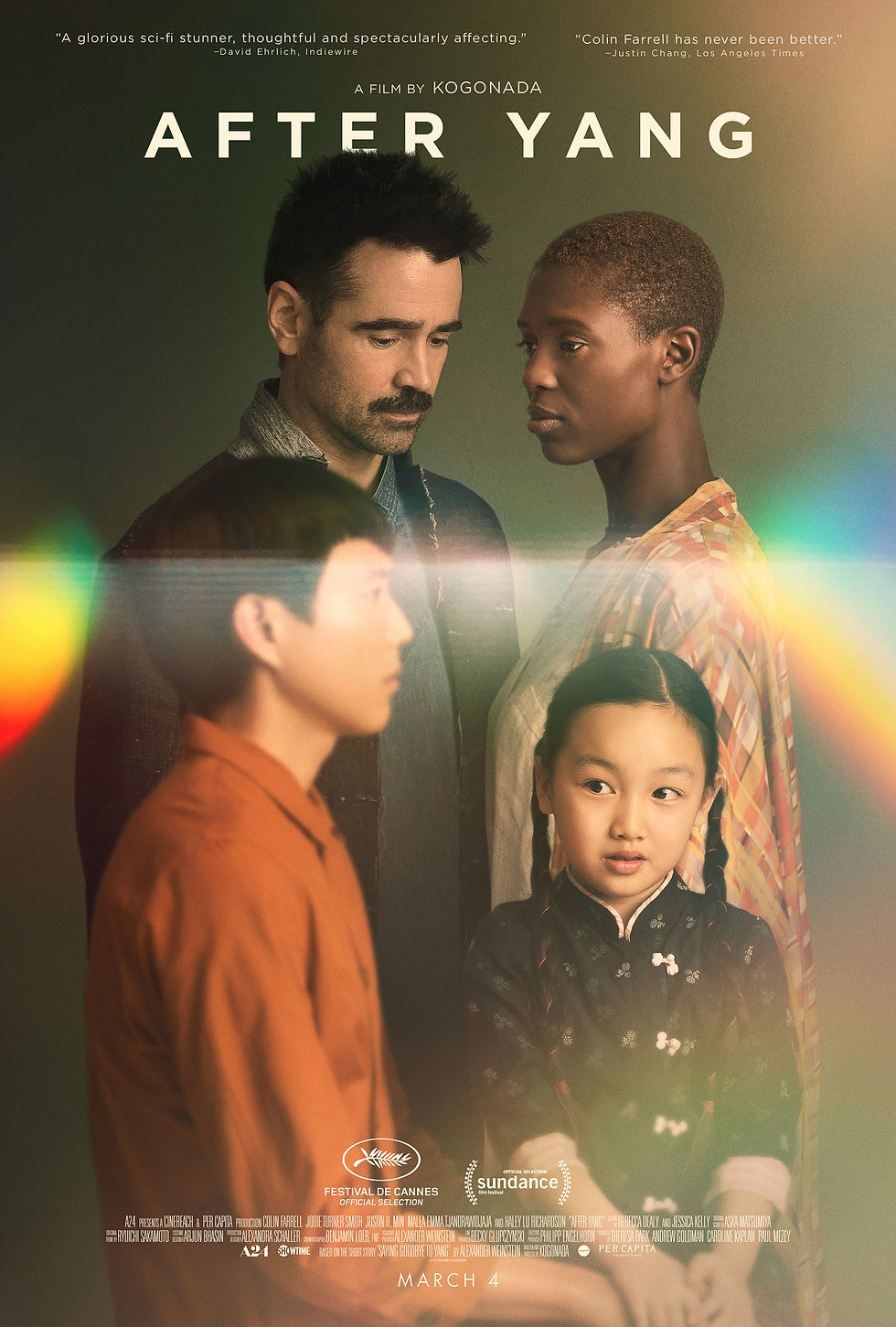
#8 After Yang
Kogonada is just a mood maker, maaaaan. It’s true too; his films are all about visual aesthetics and understated performances which combine to make an impression. His debut, Columbus, featured these often static shots of city architecture that were nonetheless sumptuous. After Yang is no less gorgeous visually, as its futuristic sci fi palette is among the very best production design of the year. Yet, like any great director, the visuals are utilized in service to story, which is here a rather melancholic meditation on the nature of personhood and loss. When Yang, the android built for their adopted Asian daughter begins to malfunction, Colin Farrell begins a quest to repair him. This leads him into ever-deepening discoveries of both Yang’s past memories and his own estrangement from his wife and daughter.
One could argue pretty convincingly that 2022 was the “Year of Colin Ferrell.” (You can watch my great friend Jason Tripp do just this in our FOF 2022 Year End Video). While some would be prone to his transformation into the Penguin and others the simpleton Padraig in The Banshees of Inisherin (count me in this group), a strong case can also be made for his soulful, low-key character study here. It’s simply lovely work and one of his very best performances to date. After Yang also features solid work from Justin Min as the titular character and Haley Lu Richardson as the mysterious girl who keeps arising in his memories. The sequence which describes the toil involved in steeping tea, between Farrell and Min, is total powerhouse cinema.
But, Yang’s conclusions about the ineffable nature of truly knowing another person, or even our own selves, is where the gold really lies. Though we all remain enigmas in some ways, it is the quest and pursuit that make for the richness of relationships. Oh, and you will not find a BETTER opening credits sequence (which entirely differs tonally from the rest of the film) ANYWHERE in this past year.
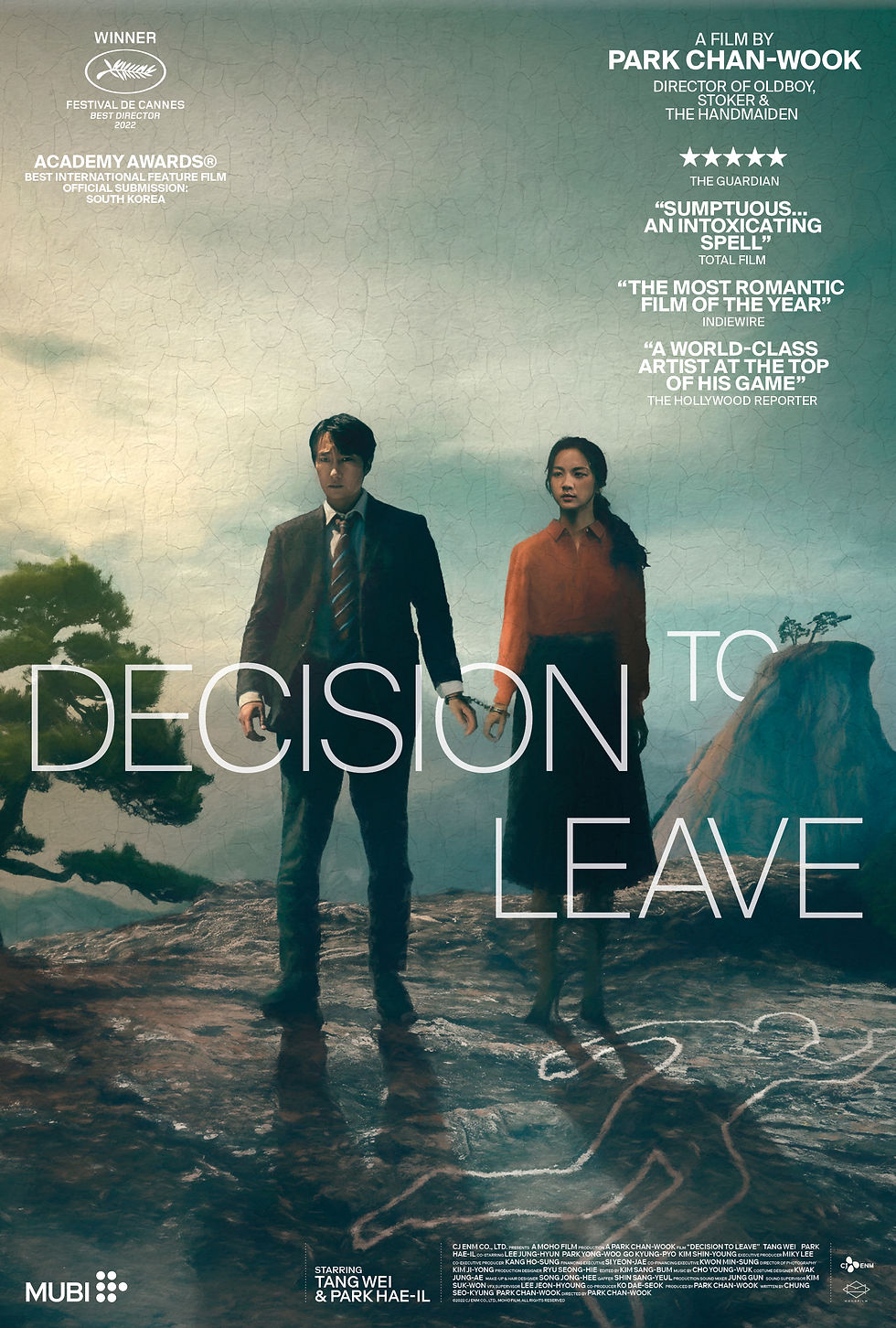
#7 Decision to Leave
What do you get when you cross a tangled police procedural, a vexing murder mystery, a techy erotic thriller and a ravishing tale of doomed romance, desire, and obsession helmed by one of the greatest visual filmmakers of a generation? Park Chan-wook’s Decision to Leave, duh. Oh, we’ve seen this one before. We’ve chowed on popcorn as Bogey or some other private dick in a 40’s noir fell for his suspect. We watched more than a few of the Joe Esterhaus’ penned thrillers which starred Glenn Close, Sharon Stone, Kathleen Turner, or…Madonna. We’ve been there for the CSI-crap, Cuz.
Fair enough, but you’ve never seen it quite like this. Park Chan-wook is channeling Vertigo and using a visual language all his own. The man’s got style for days, and he uncoils it here in a picture where every single shot seems well-planned. In some moments, Park changes the mise en scene right in the middle of a sequence. At other times, he’ll have an investigator on a stakeout outside envisioning themselves in a room, only for us to find them right there PHYSICALLY in the next frame. I could go on and on and talk about the way he captures text messages onscreen, but I digress.
The thing is, this is not just some style over substance work of mediocrity. No, it is much deeper. For one thing, Tang Wei gives one of the greatest femme fatale performances I’ve ever seen in this or any other noir. Park Hae-il, as the detective, is sufficiently gobsmacked and yet obsessive in his quest for the truth behind this murder. The story is meandering, to be sure, but I believe this to be by design. It demonstrates the labyrinthine nature of investigative work. Regardless, as things progress, the illicit chemistry between the two leads becomes almost palpable.
The plot begins to sort itself out from a whodunit to a why-did-they-do it. Discoveries are made and the film gives way to a gut punch of a denouement that leaves us alternately shattered, touched, and scrambling to piece together the divergent threads. In the end, though some may find the behavior of these two vexatious and wonder where their rooting interests lie (since when do private eyes and femmes ever behave responsibly in these kinds of stories anyway?), Park Chan-work masterfully blunts his previous melodramatic flourishes in service of a grittier true-crime story which packs one hell of a right hand.
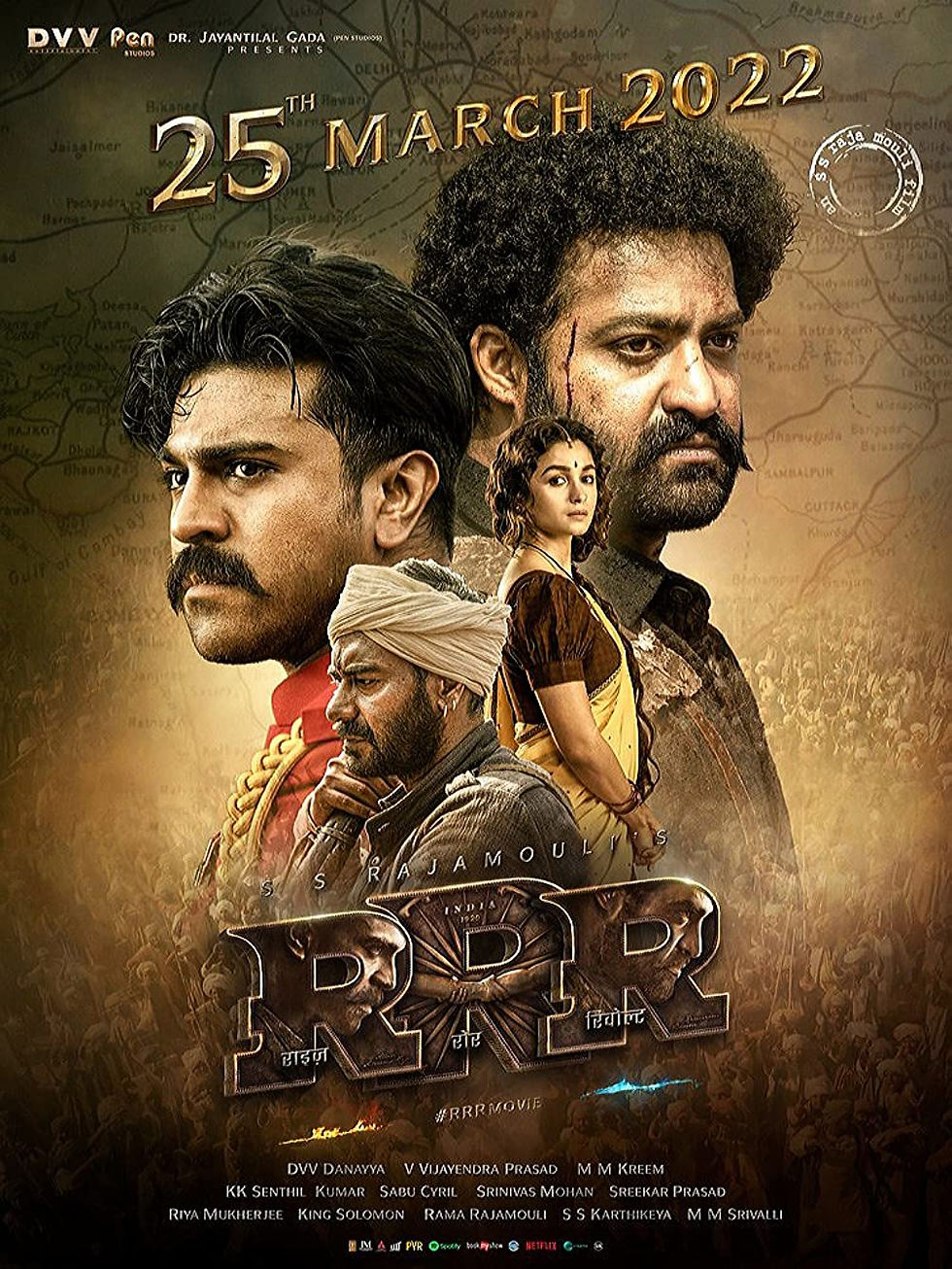
#6 RRR
Here comes my rant. NOT ENOUGH PEOPLE ARE TALKING ABOUT RRR. Rise, roar, revolt! Let’s get it together, people! This is the second best time I had at the movies all year. Eh, maybe the third (see numbers 4 and 1 below). I just can’t recommend it highly enough, if you’re the kind of person who loves epic action sequences, open-hearted bromance, buddy comedies, and a kitchen sink approach to story and genre. (Oh, so that’s almost everyone? Yeah, exactly!) In so many ways, this one blew me away. It features a single man fighting an entire horde armed only with his chiseled body and terrific mustache. The other lead, not to be outdone, outruns and traps a tiger. Then the two save a child using a flag and a motorcycle, before executing the sickest dance sequence I’ve ever seen in my life. (Naatu naaaaatu!) My bodily sensors are tingling at the mere memory. (And I didn't even mention the village rifle battle or the shoulder-riding tag team finale)!
We should also note that this it the most expensive Indian film ever made. In 2009, when Slumdog Millionnaire was on its meteoric rise, some of you (like me) may have learned about this wondrous place called Bollywood, which produces 5 times the output of Hollywood all while including massive dance numbers and sweet tales of bravery. Well, this is Tollywood, the Telugu language counterpart, and these are two of the biggest stars on the planet. It’s like if we grabbed Leo and Cruise, or peak 80’s Arnold and Sly (or Van Damme) and tossed them together into an epic saga with so much slow mo your brain may need rewired.
What else remains to be said? The score is rapturous. Musical numbers both further the narrative in a sing-songy fashion and punctuate key scenes. And, of course, the big bad here are these snooty, uppity British colonialists which decide to capture the little sister of one of our heroes for mere pleasure. There is no subtlety or nuance anywhere, but don’t mistake that fact for a lack of storytelling chops. For the inner workings of these two men’s lives and their motivations for action richly unfold across the three hour runtime. This is a work of TOTAL maximalism, baby. A film where everything is on 11 all of the time. Epic superhuman origin stories which, though containing way too much slo mo and bad CGI-ed animals, still gleefully take a giant dump on all this middling American superhero fare.

#5 Tar
Lydia Tar is everywhere. Her influence is ubiquitous, or didn't you know? No, you hadn’t heard of her? Well that’s because she isn’t real. But Todd Field’s screenplay and direction, the intricate nature of his writing and the real-world figures which populate this drama are so finely honed, that one could be forgiven for making that mistake. His writing is so meticulously detailed, in fact, that it threatens at several places to be overwritten. Fortunately for us, it is not, and instead, it’s brought to life by a genuinely titanic performance by Cate Blanchett. These are the two greatest things to recommend the picture.
Now, I would say that everyone loves a rise and fall tale, but Tar is not precisely that. When we meet Miss Lydia, she is on top of the world, sitting down for interviews with the New Yorker’s Adam Gopnik, acting as maestro for a major German orchestra, and preparing to record a live performance of the vaunted Mahler’s Fifth. In actual fact, Tar is a depiction of that fall from grace, one which unfolds in a peculiarly modern way (read: mainly online), and leaves a scathing examination of power and its potential for abuse in its wake.
Let’s take a moment to look “under the hood’ at some of the timely themes that arise in Todd Field’s masterwork. In the sickest oner of the year, Blanchett takes down a student who claims (as a queer) that he cannot get with Bach due to the patriarchal nature of his private life. Here she attacks aspects of identity culture, in a discussion of whether one can properly separate art from the actions of an artist. Later, a supercut of this encounter is dispersed widely online and the picture then grapples with cancel culture. In between these two “cultures,” we get a disquisition on the nature of personal mythmaking, the performance of self, and the ways that we curate or brand ourselves into neat packages to sell to the world. The film is heavily in dialogue with social media in this way, and as such, it is the revelation of past abuses through emails and the aforementioned hypercut which begin to show chinks in Tar’s armor.
Soon, the picture moves into a final hour which has been alternately dubbed “Kubrickian” by many critics or phantasmagoric (by moi). Irregardless, the point is that surreal elements threaten to infiltrate the narrative until we’re not certain what is objectively real and what is an artistic rendering of her descent. Though to me not a perfect film (we can discuss my gripes with the third act offline some time), Tar is nonetheless a spellbinding return for a long absent writer/director and an actress at the top of her craft.
-Check out a full video review on our youtube channel here.

#4 Top Gun: Maverick
Do you really need me to tell you why Top Gun: Maverick is a complete miracle in the post-pandemic theatrical space? Are you not one of the BILLION plus people who saw it? Well, if you’re new in town or simply need the refresher, let me help you: It is a spectacular marvel which blows the mind as well as the senses. Why? Imagine this - A film drops into the world’s in ’86 containing so many memorable touchstones, from bomber jackets to Great Balls of Fire, it truly takes the world by storm. Netting over 300 million at the domestic box office, Top Gun cemented Tom Cruise’s A-list status as the next big thing while utilizing an aerial assault to bolster late director Tony Scott’s stylistic resume. The original was “iconic” in the truest sense of the word. (You can read about that here).
So, imagine our surprise when Cruise and co. shot this long-belated sequel, wrapped production well before the pandemic, shelved it for YEARS because its sexagenerian lead was convinced that it held the power to “save cinema,” and then dropped it in our laps with the firm conviction that it was a stone cold masterpiece. And you know what? They were right! In truth, Top Gun: Maverick surpasses the original in just about every way possible, and it does so with fiercely entertaining panache.
Let’s face it, this is the very best kind of fan service. Maverick is a picture that is littered with callbacks, to be sure. But rather than hold the story hostage, these references are subtle and organic to the overarching narrative. Beyond that fact, as I said, this is just a better film on just about every other level. Perhaps Top Gun walked so Maverick could fly. (Eesh…cringe) The beats are the same, but the tech is better, the sound design is bone-shaking, and the shots are awe-inspiring. Some old favorites return, but they’re joined by a whole new cadre of flight schoolers. The group is more diverse in personalities, looks, and so much more. More importantly, they’re also more well-drawn and a critical part of the tale, as opposed to a vestigial organ in the original.
The story itself manages to be a rehash that somehow goes to new depths and soars to new heights. It sounds hokey in the framing, but I was deeply satisfied with where this one ended up. The Maverick-Goose-Rooster conundrum is mined for solid depths, and Jennifer Connelly is vastly superior to Kelly McGillis as a love interest. Finally, to hear him tell it, Tom Cruise may have just put all of theatrical moviegoing on his shorter-than-he’d-like-you-to-think frame. But fortunately for us, the old bugger has still got it. He may not hold a single Oscar statuette (what a crock!), but he’s been a shining star most moments from the original until today. Three cheers also for the smart and deft direction of Joseph Kosinski, who put cameras inside of real planes in the sky. His work will stand the test of time for being a sequel that, though less 80’s coke-y than its forebearer, is nevertheless an entirely winning summer blockbuster.

#3 Aftersun
Well look, friends. It’s about that time. We’ve been at this for awhile now. It’s been a pretty long journey from number 20 to the top 3. So I’ll beg your forgiveness for cheating some on this one. Truth be told, I wrote a rather lengthy essay on Charlotte Wells’ STUNNING debut film, Aftersun, after my initial viewing. Sure, I’m partial, but I actually think it’s quite good. For the most part, I’m just going to highlight a few things now and then point you towards that northern star. Have no fear, I am confident that it will guide you to the truth you seek.
Aftersun is a film which is one part vacation movie, a healthy sprinkling of poignantly awkward coming-of-age moments for a preteen in her burgeoning adolescence, a dash of father-daughter heartstring pulling, and, in some emphatic instances, a genuine mystery. It is each of these all at once and, sometimes, in turn. But it is also the kind of exploration of memory the likes of which I've never seen before.
On the one hand, it is the simple and rather blasé story of a father and daughter going on vacation together one summer in Turkey. On the other, a much more intimate portrait of a father wrestling with some past pain and the memories through time of a young lady at a key time of transition.
I adore the picture for its artistic conception, two powerful leads, and the hazy cinematography which so deftly captures the experience of looking back on our past from a distance. But don’t just take my work for it. Read the words of a far more serious critic here.
-Check out a full video review on our youtube channel here.
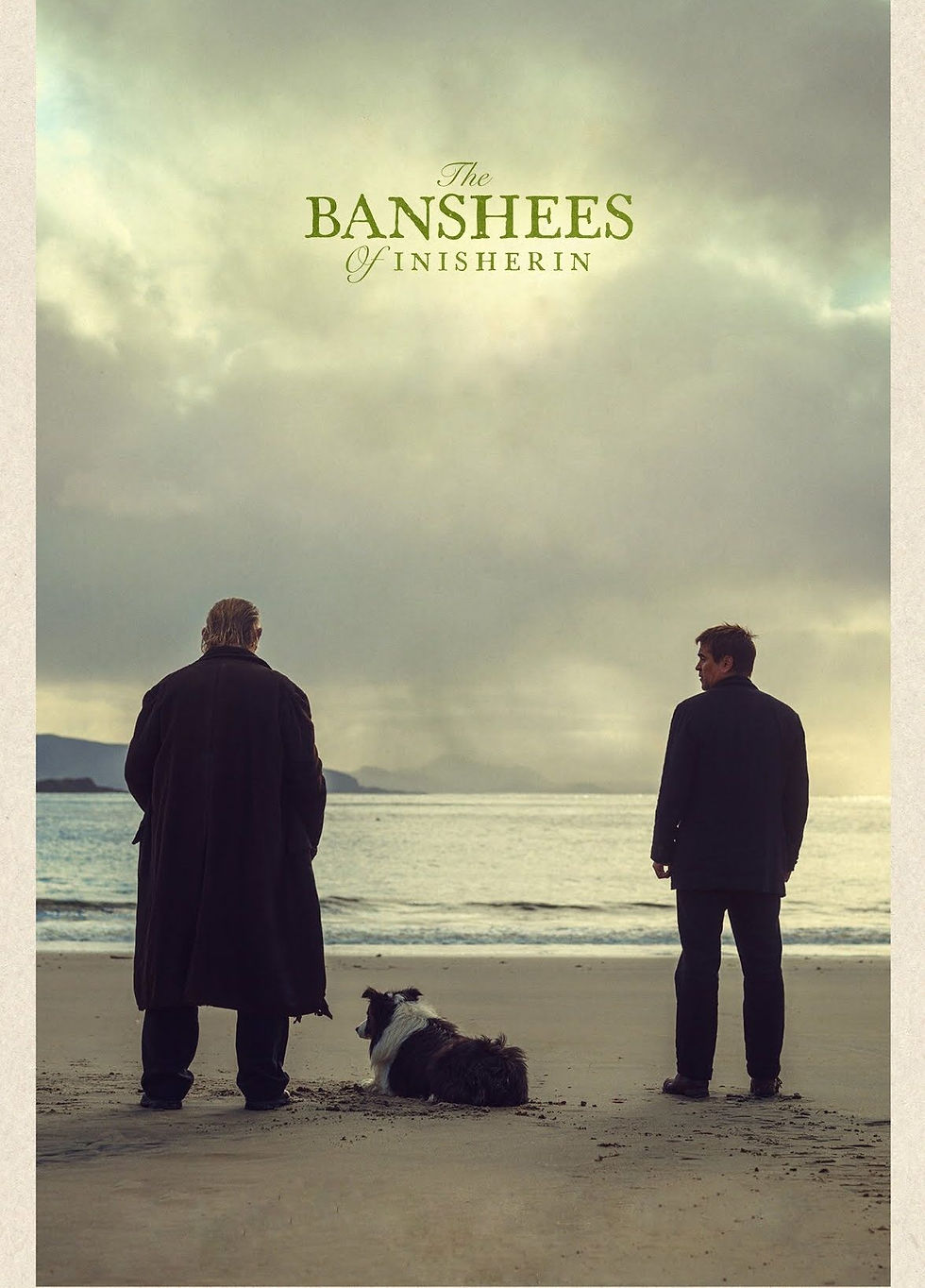
#2 The Banshees of Inisherin
“I just don’t like ye no more.”
Rarely has a film started with a simpler premise. It is, in a sense, the oldest of tales. Like a child approaching another on a playground and stating, “I don’t want to be friends anymore,” Martin McDonagh’s new masterpiece The Banshees of Inisherin appeals to our most primeval selves. To those fundamental aspects of the human spirit, where we hold concepts like friendship, betrayal, and legacy most dear.
The tale is age-old, but this particular time in history seldom visited. McDonagh is undeterred, however, and so casts us into a fictional isle off the Irish mainland in the heat of the Civil War circa 1923. It is a locale where stacked stone walls line the streets, everyone knows their neighbors “comings and goings,” and mortars can be seen (and heard) in the not-too-distant background. Though the conflict remains a backdrop in the picture’s proceedings, it yet stands to cast the relationship between the two men at its heart in stark relief. Better yet, their conflict seems to serve as snow globe or microcosm for factions and feuds writ large across the entirety of the human experience. Wars start small (like say a conscious unfriending) and grow to titanic proportions, McDonagh seems to say.
Padraig (Colin Ferrell) is a lovable dullard who is as apt to relay intimate details about his barnyard animals’ shite as to buy your next pint. In Ferrell’s able hands, Padraig is equal parts childlike naivete, tenderhearted spirit, and eternal bore. Colm (Brendan Gleeson), by contrast, is far Padraig’s superior in both age and intellect (at least in his mind). He is a man who seems to be at a crossroads himself internally, where considerations of legacy amidst existential despair take center stage.
As the reader will have already gathered, the inciting incident here is a choice Colm makes to simply ghost Padraig one day when the latter goes to fetch him for their afternoon pint at the local dive. Because of Padraig’s fun-loving and slow-learning nature, he is unable to comprehend the impasse into which Colm has cast him. So he persists in trying to make amends, and tensions and actions escalate. The rising action soon brings inexplicable actions (think literary irony 101), heated feelings, and an ominousness which threatens to engulf us.
While the performances will likely get most of the plaudits, (I must now stop immediately and give Kerry Condon her laurels. Her tender yet fiery showing really locates her as the heart and soul of the picture, the mediator between these two men behaving badly) the writing might just be the true genius of the picture. It moves and pulses with its own rhythm and cadence. Are we rowing? Seems like we’re rowing. The vernacular places us in a distinct time and place and almost becomes its own character. McDonagh is also so adroit at knowing when to drop just the perfect affecting line in key moments along the way.
Since we have released our Banshees video on our Furman on Film YouTube channel, what has struck me so poignantly about the film is its remarkable ability to be both of a particular time and place and universal in its messaging. We’ve heard from people all over the beautiful isle of Ireland with their own unique thoughts on what McDonagh is pointing to in their homeland. At the same time, its reflections on love and friendship and the nature of betrayal are simple enough for a child. This is, after all, a striking modern fable in the very best sense. What I’m left with personally is not only this deep wellspring of rumination on legacy (What will remain of what I’ve accomplished after I am gone?), but the paramount importance of relationships. It’s the people we’ve touched, brushed up against, and interacted with, even influenced positively, that linger on long after we (and all our works) have returned to dust.
-Check out a full video review on our youtube channel here.
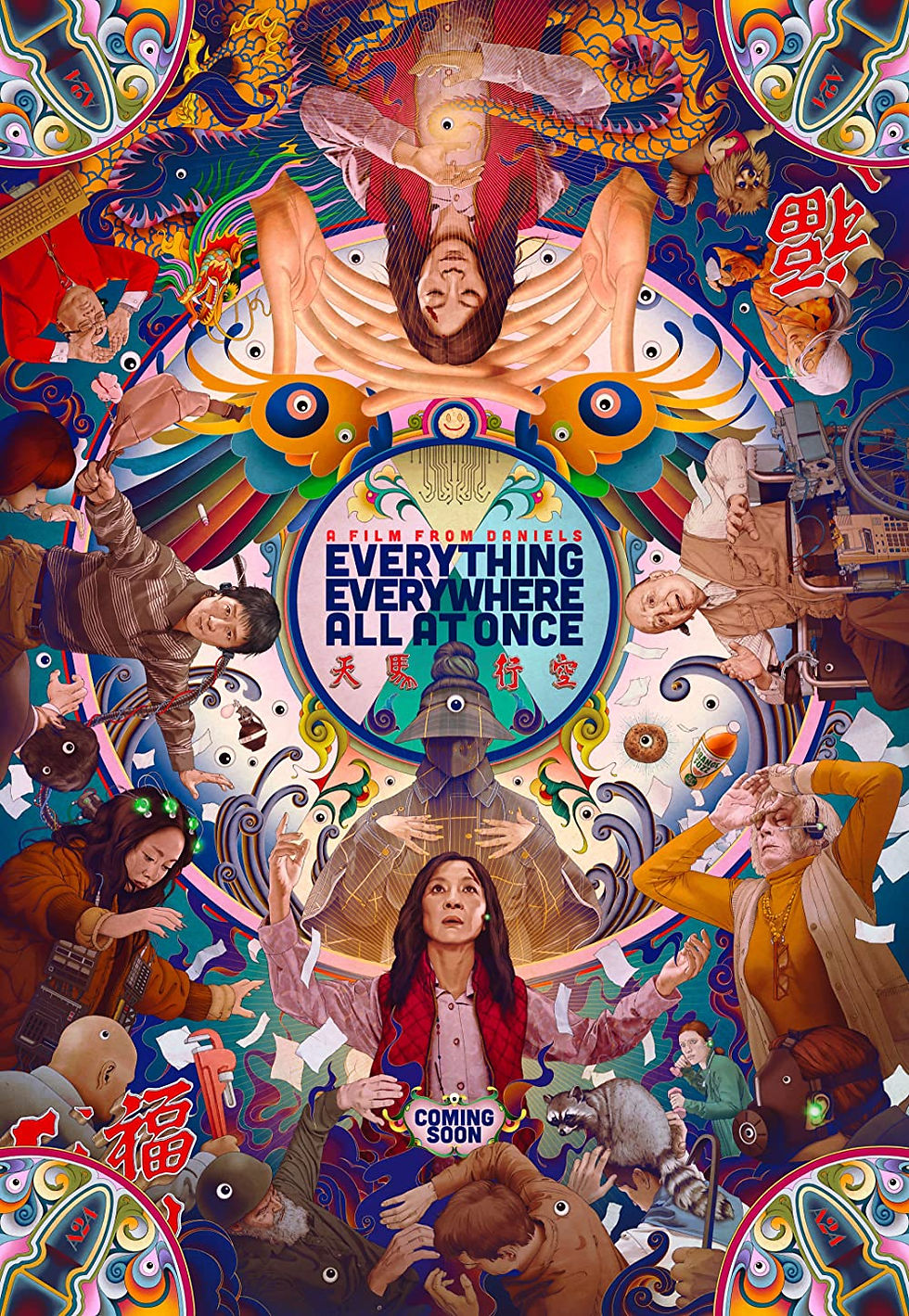
#1 Everything Everywhere All At Once
No other film made me feel as alive, as human, and as connected in 2022 as Everything Everywhere All At Once. We’ve reached the end of our journey, and this one deserves about a 15 paragraph essay. But I’m almost tempted to just leave that single sentence above and drop the mic.
In truth, I just didn’t think what the Daniels pulled off here was even possible. I mean, what was the storyboarding process even like?
(The following conversation MAY have never happened. It is possible that it is a distillation of what occurs when plebes like me imagine geniuses at their craft)
D1: So listen, man. We’ve got an Asian immigrant family.
D2: Right.
D1: They’re just trying to pay their taxes, bro. Like, mounds of invoices and papers.
D2: No doubt. And?
D1: Well, they’re being hounded by a cantankerous tax collector.
D2: OK. So let’s make this Jamie Lee Curtis.
D1: Whaaaat….oh. Ok. Yeah. That could work!
D2: Have I ever let you down? Sorry to say though, man. There’s not enough here.
D1: Well yeah, that’s because we haven’t talked about the multiverse yet.
D2: Oh snap! The multiverse? Suck on that, MCU! I’ve gotta say though, man. I have one demand.
D1: Shoot.
D2: I’m only doing multiverses if there are kung fu homages.
D1: *Begins to nod*
D2: No. Breathtaking, long montages of ridiculously inventive kung fu.
D1: Mmm ‘kay. And we’re getting Michelle Yeoh for it. Of course.
D2: Sometimes I feel like you really get me, man.
D1: You got any other ideas?
D2: Bro. Multiverses. We’re gonna need match cuts. A sick, SICK amount of match cuts. It’s gonna be the greatest editing they’ve ever seen!
D1: Naturally. But I forgot to tell you the final details.
D2: I was hoping there was more. So far we’ve got an action sci fi banger. Transcendent? I think not.
D1: Hold up. The family at the center of it….the couple is estranged.
D2: Oooh.
D1: About to file for divorce. That kind of estranged. And the mother and daughter…
D2: They can’t connect on anything, right?
D1: Nailed it.
D2: So that’s the REAL journey across the galaxies. Finding out what really matters.
D1: Daniel.
D2: Yes.
D1: I’ve never felt so seen by you.
D2: I love you, Daniel.
D1: I love YOU. Daniel.
So that’s the goods really (read: plot). I could talk about how Michelle Yeoh has been a largely unnoticed titan of cinema for decades. Or that Ke Huy Quan injects this crazy affair with more pathos and…kindness…than entire Lifetime original specials. The multiple roles that Stephanie Hsu inhabits with grace and aplomb are another touchstone. EEAAO (coolest acronym ever) is simply a showcase for tremendous talent onscreen and behind it. Scholars should be showing its editing prowess in film studies courses for decades moving forward.
Did I mention it’s also baldly hilarious? The movie features running bits which poke fun at or riff on other films (Ratatouille, In the Mood for Love) or recurring motifs (yes, hot dog fingers) which are mined for humor and, shockingly, genuine empathy. Again and again, I was blown away by the masterclass of spinning plates that the Daniels captured on celluloid here. There is truly nothing like this in existence.
But its lingering effect on me lies in how EEAAO comes to an achingly poignant and deeply touching conclusion. It’s dazzling montage on acts of kindness left me in ruins. The final sequence of the “rock world” uses prop objects to show one of the most heartwarming parental acts of support and long-suffering you’ll find anywhere. Enter awkward ugly cry number two.
Still, all of this pales in comparison to the highgrade potency of its lasting lessons on what REALLY matters in our years of breathing on this spinning orb. In the face of utter experience and ever-encroaching meaninglessness (watch it and this will make sense), once again relationships are king. Thank you, Daniels, for the best film of this young decade.
-Check out a full video review on our youtube channel here.
**Review contains spoilers.**
Honorable Mentions:
Causeway
The Batman
Both Sides of the Blade
Puss in Boots: The Last Wish
Weird: The Al Yankovic Story
Fire of Love
Armageddon Time
Speak No Evil

Comments